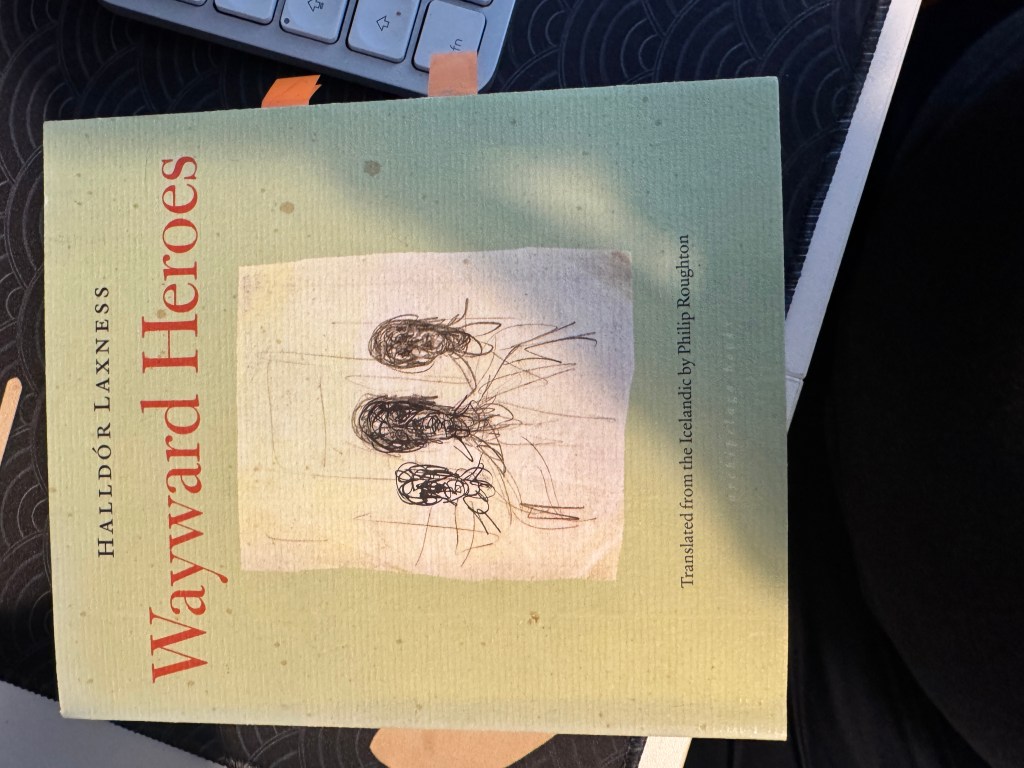
Wayward Heroes by Halldór Laxness
Icelandic fiction
Original title – Gerpla
Translator Phillip Roughton
Source – Personal copy
When I first looked at the list of books for the year of 1952,, this book was one of the first to catch my eye as I had a book set in Iceland in the last club year, and I have also covered a couple of other books from Laxness and I love the fact that his books are getting newer translations in recent years. This is the case with this book, which came out a few years ago. I bought the American copy, so I’m not sure how it was published in the UK. As I’m a massive fan of Archieplagpo books, I think they’re works of art in themselves. Anyway, this came in the later part of his writing years and was his take on the Icelandic sagas. But apart from that, he had used the saga style of telling a story to make an ancient saga, as told, reflect events that were happening at the time the book was published, not long after World War II, at the start of the Cold War. He has cleverly rebuilt the sagas to use the past as a mirror to the present
Then Jöour Klangsson rode away. It was near sunset. When Jour was gone, the boy jumped down, walked over to where his father was lying across the path, and took a closer look at his body. The blow had disfigured his face, and blood and brains oozed like porridge from the crack in his head. One of his arms jerked at the shoulder before the man went limp and died – that twitch was his last. Porgeir Hávarsson was astonished at how easily his father died, despite his having fought berserkers in Denmark and brought fire and slaughter to Ireland. He had always believed his father to be one of the greatest champions in the North. The boy stood outside for a long time before going to tell his mother. Finally, he went in. He was seven years old at the time.
The end of the first chapter
What he has done in his retelling of the sagas is turn them on their head and see how the violence the Vikings committed all over Europe was, at times, senseless violence that followed them around the world. So at the heart of the tale, brothers Þormóður and Þorgeir are based on actual figures in the Icelandic sagas. But what he does so well as he recounts their adventures and eventual deaths is that it is barbaric, and also tells the story comically, with a nod towards events happening in the world he knew in the 1950s. From them getting stuck and what others view as trollo like figures in the North of Greenland looking after them (I found it strange with all the recent coverage of another barbarian in Trump wanting this country) The style is like being sat at a fire for weeks at the brothers years of travel and m ishaps and violence is recounted!
PÓRELFUR, PORGEIR Hávarsson’s mother, came from Hordaland in Norway, a region harsh and forlorn, where it had long been the custom for men’s sons who had little chance to thrive to travel abroad and acquire wealth through plunder.
Some went to Russia, others to the British Isles. In Hordaland, those who never undertook a Viking raid were deemed worth-less. Yet none knew more valiant tales of the trials of the Vikings, their battles and sea-voyages, than those who never ventured from home. Among these, it was the nursemaids who had the best stocks of lore. In fair verses, they extolled the Vikings feats: the prowess, valor, and gallantry that true men display in distant lands, yet do so more rarely the closer they are to women. For the young sons of Hordaland crofters, such lore was the only provision and dowry that they received from their mothers before leaving home – and likewise, Pórelfur had little else to lavish on her son than tales of the prowess of champions of yore and paeans to kings who win the devotion of ambitious crofters’ sons with their bounteousness, rewarding stout hearts with weighty rings.
The openiong of the third chapter capture that saga style well, as far as I know !
Now I haven’t read the Icelandic sagas, I felt this might help with the style of the book, which has a specific flow that feels remarkably like it is trying to be in the style of the sagas with a modern twist and comic in style, which is hard to pull off. Still, he does in parts, and thus the novel could be told by firelight. At times, this makes it hard to follow as every detail of people is built as the prose slowly builds at times and is also maybe a little hard to follow as A reader, I had start this monthgo and if it wasn’t for the fact I had pick it up now for this week I would maybe waited a while to get back to it. But it is also easy to see how the brother’s adventures could be a mirror of all that is going on at the time the book was written, and also now. A lot of the book is around the brother sailing and taking over different places, but also in a way, this has a modern twist to the time, just as the Cold War is beginning, and those lines around Europe are being changed, and violence and people taking over places is still happening. Have you ever read any books by Halldór Laxness?
Related
Published by








